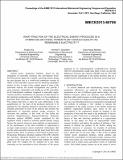What Fraction of the Electrical Energy Produced in a Hybrid Solar-Fossil Power Plant Should Qualify as ‘Renewable Electricity’?
Author(s)
Iora, Paolo; Ghoniem, Ahmed F; Beretta, Gian Paolo
Downloadv06at07a045-imece2013-66706.pdf (638.4Kb)
PUBLISHER_POLICY
Publisher Policy
Article is made available in accordance with the publisher's policy and may be subject to US copyright law. Please refer to the publisher's site for terms of use.
Terms of use
Metadata
Show full item recordAbstract
Hybrid power production facilities, based on the integration of renewable resources into conventional fossilfuel- fired power plants have gained a growing interest during the past decades due to a world-wide continuous increase of shares of the renewable sources into the electricity generation market. In fact, in spite of the variable nature of most of the renewable sources, the hybrid configuration may provide a more economic, sustainable, and reliable use of the renewables in all load-demand conditions compared to renewable singleresource facilities. Nonetheless, the question of what fraction of the electricity produced in such facilities is to be considered as generated from renewables, still remains not fully addressed. This implies that there is space for some arbitrariness in the quantification of the share of the produced electricity to be qualified for the subsidies granted to renewable electricity, as normally prescribed by most of the policies that promote the applications of renewable primary energy resources. To overcome this problem, in this work we first define the classical Single-Resource Separate-Production Reference allocation method (SRSPR) usually considered by the regulators which is based on reference partial primary energy factors that must be chosen by some authority as representative of the performance of the (best available or representative average single-resource) power production technologies that use the same renewable resource and the same fossil fuel as the hybrid facility. Then we propose a Self-Tuned Average-Local- Productions Reference allocation method (STLAPR) whereby the electricity allocation fractions are based on the energy scenario of the local area of interest that includes the hybrid plant itself. We compare the two methods for a case study consisting on the renewable-to-fossil allocation of the power produced in an Solar-Integrated Combined-Cycle System (SICCS) with parabolic trough solar field. It turns out that the differences between the classical SRSPR and the STLAPR method become significant as the hybrid facilities take on a sizable fraction of the production of electricity in the local area.
Date issued
2013-11Department
Massachusetts Institute of Technology. Department of Mechanical EngineeringJournal
Volume 6A: Energy
Publisher
ASME International
Citation
Iora, Paolo, Ahmed F. Ghoniem, and Gian Paolo Beretta. “What Fraction of the Electrical Energy Produced in a Hybrid Solar-Fossil Power Plant Should Qualify as ‘Renewable Electricity’?” Volume 6A: Energy (November 15, 2013).
Version: Final published version
ISBN
978-0-7918-5628-4